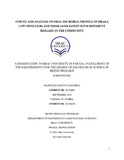| dc.description.abstract | This research aims to determine the composition of the human oral microbiota, comprising various
microorganisms inhabiting the oral cavity exist in the human mouth. The oral microbiota plays a
vital role in human health, with growing evidence linking it to systemic conditions such as
diabetes, obesity, cancer, and even diseases beyond the oral cavity, including rheumatoid arthritis,
adverse pregnancy outcomes, and cardiovascular diseases. Furthermore, a substantial number of
oral microorganisms can transit to the digestive tract, fostering close associations with digestive
disorders. Notably, a large number of oral microorganisms enter the downstream digestive tract
from the oral cavity through saliva, and they present a particularly close relationship with digestive
diseases. (Iyer, P. 2023). The presented study was undertaken to find the mostly available bacteria
in teeth, among the isolates, the most prevalent organism was Klebsiella and Pseudomonas species
as the most abundant, followed by Staphylococcus species. Clinical oral samples were collected
from two distinct dental clinics, encompassing 25 patient samples. However, probable
microorganism Klebsiella was identified in 96% of the samples, Pseudomonas species
microorganism (96%) and Staphylococcus species microorganism (88%). Subsequently, antibiotic
susceptibility test was carried out for 15 antibiotics from different antibiotic classes in conjunction
with biochemical assessments following gram staining. Additionally, patient surveys
encompassing oral health, lifestyle, and dietary habits were conducted. All 25 clinical samples
exhibited 100% resistance to four common antibiotics: Doxycycline, Penicillin, Ampicillin, and
Cefixime. which is alarming. Furthermore, the study observed that many patients harbored diverse
microorganisms while undergoing antibiotic treatment. In terms of microflora, Klebsiella and
Pseudomonas was in maximum number of samples. Comparatively, non-clinical isolates displayed
a lower prevalence of pathogenic microorganisms, with 16% Klebsiella, 24% Pseudomonas, and
8% Staphylococcus. After the study, and comparing both the non-clinical and clinical isolates, it
could be said that Clinical isolates tend to exhibit higher pathogenicity. Along that study, statistical
tests were also performed to find out significant associations from the data. | en_US |

